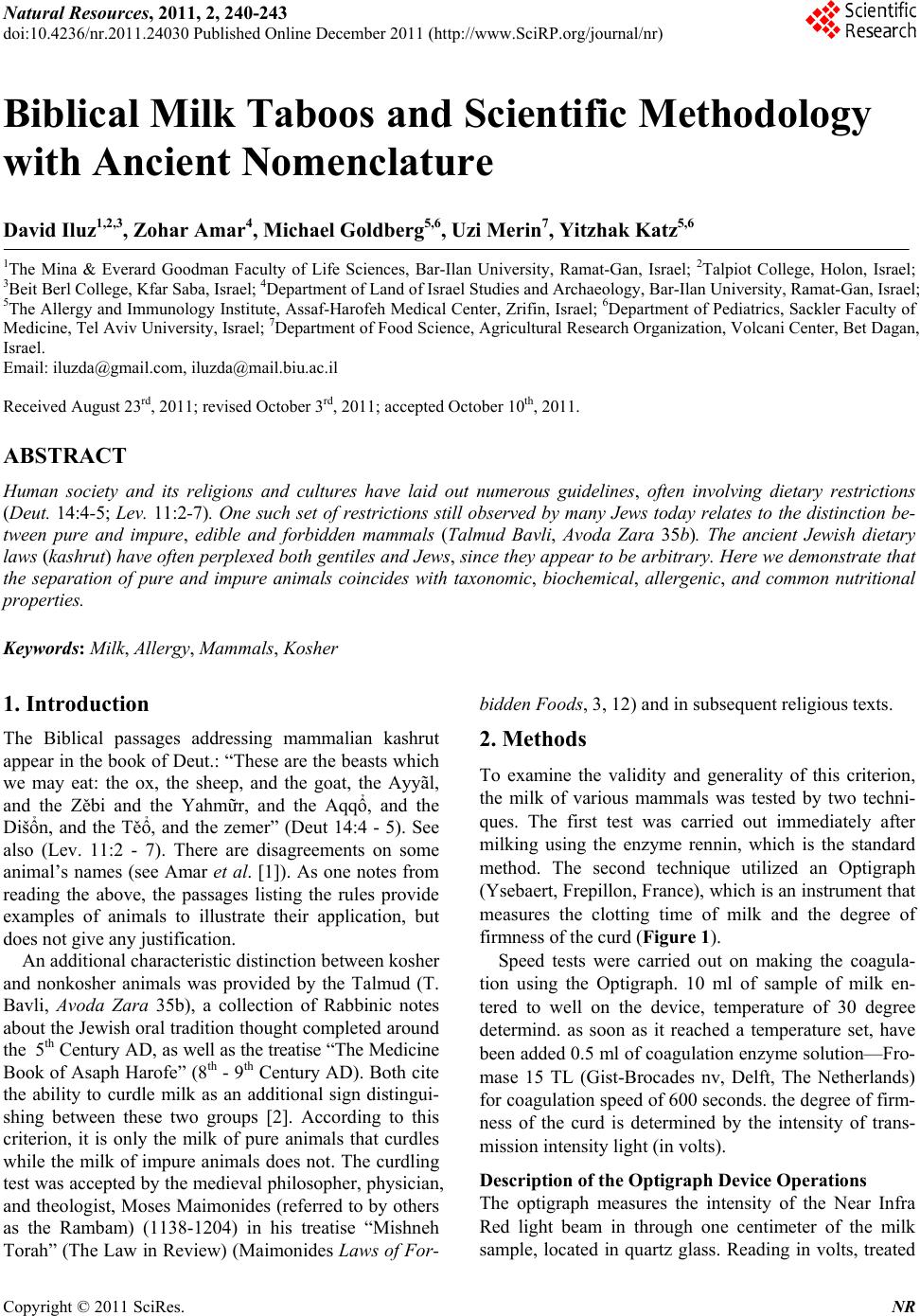
Natural Resources, 2011, 2, 240-243
doi:10.4236/nr.2011.24030 Published Online December 2011 (http://www.SciRP.org/journal/nr)
Copyright © 2011 SciRes. NR
Biblical Milk Taboos and Scientific Methodology
with Ancient Nomenclature
David Iluz1,2,3, Zohar Amar4, Michael Goldberg5,6, Uzi Merin7, Yitzhak Katz5,6
1The Mina & Everard Goodman Faculty of Life Sciences, Bar-Ilan University, Ramat-Gan, Israel; 2Talpiot College, Holon, Israel;
3Beit Berl College, Kfar Saba, Israel; 4Department of Land of Israel Studies and Archaeology, Bar-Ilan University, Ramat-Gan, Israel;
5The Allergy and Immunology Institute, Assaf-Harofeh Medical Center, Zrifin, Israel; 6Department of Pediatrics, Sackler Faculty of
Medicine, Tel Aviv University, Israel; 7Department of Food Science, Agricultural Research Organization, Volcani Center, Bet Dagan,
Israel.
Email: iluzda@gmail.com, iluzda@mail.biu.ac.il
Received August 23rd, 2011; revised October 3rd, 2011; accepted October 10th, 2011.
ABSTRACT
Human society and its religions and cultures have laid out numerous guidelines, often involving dietary restrictions
(Deut. 14:4-5; Lev. 11:2-7). One such set of restrictions still observed by many Jews today relates to the distinction be-
tween pure and impure, edible and forbidden mammals (Talmud Bavli, Avoda Zara 35b). The ancient Jewish dietary
laws (kashrut) have often perplexed both gentiles and Jews, since they appear to be arbitrary. Here we demonstrate that
the separation of pure and impure animals coincides with taxonomic, biochemical, allergenic, and common nutritional
properties.
Keywords: Milk, Allergy, Mammals , Kosher
1. Introduction
The Biblical passages addressing mammalian kashrut
appear in the book of Deut.: “These are the beasts which
we may eat: the ox, the sheep, and the goat, the Ayyãl,
and the Zěbi and the Yahmữr, and the Aqqổ, and the
Dišổn, and the Těổ, and the zemer” (Deut 14:4 - 5). See
also (Lev. 11:2 - 7). There are disagreements on some
animal’s names (see Amar et al. [1]). As one notes from
reading the above, the passages listing the rules provide
examples of animals to illustrate their application, but
does not give any justification.
An additional characteristic distinction between kosher
and nonkosher animals was provided by the Talmud (T.
Bavli, Avoda Zara 35b), a collection of Rabbinic notes
about the Jewish oral tradition thought completed around
the 5th Century AD, as well as the treatise “The Medicine
Book of Asaph Harofe” (8th - 9th Century AD). Both cite
the ability to curdle milk as an additional sign distingui-
shing between these two groups [2]. According to this
criterion, it is only the milk of pure animals that curdles
while the milk of impure animals does not. The curdling
test was accepted by the medieval philosopher, physician,
and theologist, Moses Maimonides (referred to by others
as the Rambam) (1138-1204) in his treatise “Mishneh
Torah” (The Law in Review) (Maimonides Laws of For-
bidden Foods , 3, 12) and in subsequent religious texts.
2. Methods
To examine the validity and generality of this criterion,
the milk of various mammals was tested by two techni-
ques. The first test was carried out immediately after
milking using the enzyme rennin, which is the standard
method. The second technique utilized an Optigraph
(Ysebaert, Frepillon, France), which is an instrument that
measures the clotting time of milk and the degree of
firmness of the curd (Figure 1).
Speed tests were carried out on making the coagula-
tion using the Optigraph. 10 ml of sample of milk en-
tered to well on the device, temperature of 30 degree
determind. as soon as it reached a temperature set, have
been added 0.5 ml of coagulation enzyme solution—Fro-
mase 15 TL (Gist-Brocades nv, Delft, The Netherlands)
for coagulation speed of 600 seconds. the degree of firm-
ness of the curd is determined by the intensity of trans-
mission intensity light (in volts).
Description of the Optigraph Device Operations
The optigraph measures the intensity of the Near Infra
Red light beam in through one centimeter of the milk
sample, located in quartz glass. Reading in volts, treated